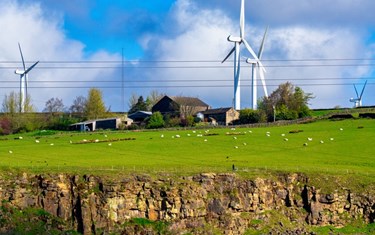This is the RTPI’s response to the CAA’s consultation on the Airspace Modernisation Strategy 2022-2040. The Royal Town Planning Institute (RTPI) supports and welcomes the chance to review and provide comment upon changes to the policy. The RTPI has consulted our relevant networks and members to provide a holistic and representative response to the consultation. Our key findings can be found below, both in our overarching comments and then in our response to some of the specific questions in the consultation.
About the RTPI
The RTPI champions the power of planning in creating prosperous places and vibrant communities. As learned society, we use our expertise and research to bring evidence and thought leadership to shape planning policies and thinking. As a professional body, we have over 27,000 members across all sectors, and are responsible for setting formal standards for planning practice and education.
General Comments
Observations
The Airspace Modernisation Strategy is built around four clear strategic objectives:
- Environmental sustainability
- Simplification – reduce complexity and improve efficiency
- Integration of diverse users
- Safety
The strategy acknowledges the challenges of net zero, and the role that the aviation industry can play in this through its continued modernisation. The strategy states that “UK airspace is among the most complex in the world, yet its underpinning design dates back to the 1950s”. What is particularly interesting for planning is the sustained growth in demand for air transport and the increasing diversification of users.
Airspace modernisation takes into account the needs and requirements of the existing and traditional users such as commercial air transport and the new users, which can range from drones, to aerial taxis and spacecraft in the future. As the strategy says “UK airspace is an essential, but largely invisible, part of our national transport infrastructure. It is a shared and (in certain regions) scarce resource”.
The forecasted growth in air traffic will have significant knock-on effects for the finite volume of airspace and the finite volume of land for which to establish access zones and storage for new technologies. Air and ground systems such as airports, will act as a single integrated infrastructure to accommodate the growth of air traffic. The strategy further states that “Remotely piloted or unpiloted aircraft will expand traditional business models and accelerate the transition towards an environment that is rich in digital information. At the core of this transformation is a strong need for a fully harmonised global air navigation system built on agreed performance-based standards with interoperable and scalable systems”.
Existing infrastructure will be required to evolve to serve the new entrants and increasing demand of UK airspace. If we are to accommodate this increasing demand, a system for managing the various technologies and air transport methods will need to be adopted. In particular, terminals will require redesigns to help accommodate both the increasing demand for air transport and the increasing diversification of transport methods.
Response
The draft Airspace Modernisation Strategy sets out how the UK can further develop the management of its airspace in line with both net zero and the technological advancements that have and will happen within that space. Whilst the strategy focuses heavily on technical developments such as signalling and navigation, there are clear areas of interest for the planning system.
Increased Demand and Diversification
The projected increase in the demand for air transport and the increasing diversification of air transport methos are two of the most significant elements for the planning system. As the demand for air transport increases, bigger terminals will need to be planned and constructed, with significant extensions to existing terminals the most likely method of facilitating the increasing demand. As the need for greater infrastructure on the ground increases, the role of planning should have a vital role to play in the expansion of air transport infrastructure. Terminals will need to be planned carefully to maximise their benefits of increased connectivity, whilst minimising the negative effects that they can have on the environment, as well as the increased levels of noise pollution.
Alongside the increasing demand for air transport, the strategy highlights the increasing diversification of air transport methods. In particular, unmanned drones and smaller forms of air transport are projected to increase in availability as technologies continue to improve and the cost of production and operation falls. These alternative transport methods will pose a new challenge to the planning system, as air transport becomes more widely accessible. Whilst some of these transport methods may fit into traditional terminals, there is also a likelihood that new forms of terminals will be required to house and facilitate unmanned drones and smaller forms of air transport. The sector could require ‘micro terminals’ that once again would need to be planned effectively, to allow them to be linked to existing forms of transport, not have any negative effects upon communities and the landscapes that surround the areas.
Supply chains and the delivery of goods may also become increasingly reliant on drones and unmanned air transport, which warehouses may need to operate as micro terminals, increasing their demand for space. Both the transport and logistics sector could benefit from the increased diversification of air transport, if the terminals and infrastructure are planned correctly to maximise their benefits and mitigate any negative effects of increased air transport.
Sustainable Connectivity
New and existing terminals should have sufficient links to sustainable public transport, to reduce the need for private vehicle use. Whilst the major terminals in the UK, and in particular the South East of England, have strong public transport links, the smaller terminals throughout the UK often have much poorer connection to public transport. This issue of connectivity, particularly outside of the South East of England, fits in with the Levelling Up agenda and furthers the importance of enhanced connectivity throughout the UK.
If the UK is to decarbonise air transport then we must think beyond just the air transport technologies and approach the issue holistically, incorporating the journeys to and from terminals. This is a key point for all forms of air transport, whether they be commercial flights, logistical transport or new technologies such as drones. By effectively planning sustainable transport links to new and exiting terminals, the sector can make greater contributions to decarbonisation throughout the UK.
In order to ensure that new and existing terminals are planned and built with sustainable transport at the heart of them then we must adopt a placemaking approach when planning an developing terminals. Whilst the air transport sector continues to strive towards decarbonising their technologies, terminals must have sustainable transport links that are accessible and affordable. Whilst some existing terminals may have public transport links they do not run around the clock and the prices of these public transport links are often deter commuters from using them. This is a problem for both those who use the terminals and those who work at them. As a result of this, new and existing terminals must embrace greater connectivity and place this at the heart of their plans for the future.
Land Use
If land is needed for more terminals, runways and potentially other forms of terminals such as ‘micro terminals’ then we must also ask the question of how this will be factored into local plans. Similarly to the issue of connectivity, there must be an understanding of how the increased demand for air transport will be managed on the ground, with finite space being available for terminals to be planned and built.
Any new terminals or expansions of existing terminals should be factored into local plans at the earliest possible stage with other factors including public transport, housing, nature recovery and energy infrastructure being included in the decision making.
National Policy Statements
The paper does not explain what the role of National Policy Statements will be in steering the airspace sector. We have grave concerns around the current lack of coordination between national policy on rail, road and air networks. We would expect the government to begin a much more integrated approach to interurban transport with a single national policy statement in future. We also have questions around how the demand for interurban travel will be met and by which mode, taking into account our climate obligations.
It is also not clear from the paper how other national governments in the UK are to be involved in working out airspace policy. As far as any land use on the ground within the territories of Scotland Wales and Northern Ireland is concerned, it will be necessary for the CAA and DfT to work very closely with the planning responsibilities of the various governments.
Renewable Energy
With the increasing drive towards net zero, paired with the recent changes in energy supply following Russia’s invasion of Ukraine, there is a change in the UK’s stance on onshore wind farms. It is now highly likely that there will be an increase in demand for onshore wind farms throughout the UK. It is important that the CAA considers the effect that the construction of onshore wind farms could have on the aviation sector, and in particular on the management of airspace, as developments on the ground have impacts elsewhere. The CAA and individual airports will likely have a key role to play in consultation and engage all parties to be active in this space.
Conclusion
Overall, the increasing demand and diversification of air transport poses many questions for the planning system and sector as a whole. Existing and new air transport terminals will need to be planned with a view to the future, to ensure that they can facilitate the demand for, and variety of, air transport. Whilst ideas such as micro terminals could be employed to allow for supply chains and logistics to utilise the technologies.
Whatever the effect is at the macro and micro level, the planning system must be involved to ensure that new terminals and expansions are planned correctly, to maximise their benefits of enhanced connectivity, whilst ensuring that the effects of the physical infrastructure and the air traffic are kept to a minimum.
Alongside this there needs to be a more holistic approach, with the relevant NPS’s detailing clear links and crossovers, whilst issues such as land use and supply being considered from the earliest possible stage. It is clear that for the airspace modernisation strategy to be a success, it needs to approach airspace management in a truly holistic manner, taking into account all of the effects that its proposals and predictions could have on the ground.


